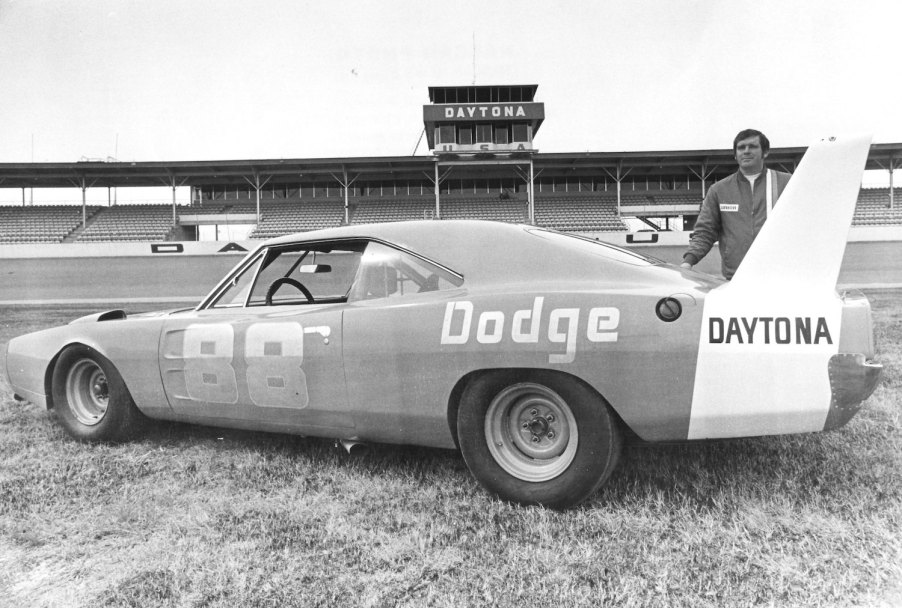
How Talladega Became NASCAR’s Fastest Track
The Talladega Superspeedway is NASCAR’s fastest track. The founder of NASCAR built this 2.6-mile track to be longer than Daytona, with higher top speeds. Banked corners make this tri-oval faster still. Talladega is the home to multiple NASCAR records, including the fastest ever official stock car speed. This incredible record still stands after thirty years.
The history of the Talladega Superspeedway

Bill France Senior was a stock car driver and founder of the National Association of Stock Car Auto Racing. He also built Daytona International Speedway which became the sport’s premier venue in 1959 and is still home to the Daytona 500. The huge, 2.5-mile tri-oval allowed the stock cars to reach unprecedented speeds. These speeds drew massive crowds. As soon as Daytona was complete, France began a quest to build a larger, faster track.
NASCAR’s founding chairman traveled up and down the east coast, searching for a location for a superspeedway. France failed to strike a deal with the government in North Carolina. In addition, South Carolina’s prohibition on Sunday alcohol sales made it an unprofitable location for a track. Finally, NASCAR found a champion in Governor Georg Wallace of Alabama. Wallace gave Bill France a former airfield between Birmingham and Atlanta. Construction crews broke ground in Talladega in 1968.
In 1969, France finally completed the Alabama International Motor Speedway. The 2.66-mile tri-oval immediately became the fastest track in NASCAR. The new Speedway hosted two major Cup series events every year. In 1989, NASCAR officially changed the track name to the Talladega Superspeedway.
From its inaugural race weekend, the new superspeedway was destined to break every NASCAR record.
The Talladega record is 212 mph and has stood for over 30 years

The Talladega Superspeedway is a 2.66-mile (4.281-kilometer) asphalt track. This longer track length allows higher top speeds than at Daytona.
Talladega officially has four corners. That said, the front straightaway features a slight outward bend to increase the overall track length. It is this shape that gives the Speedway its tri-oval shape.
The four primary turns are all banked between 32 and 33 degrees. In addition, the bend in the front straight is banked at 16.5 degrees. This high bank angle allows cars to corner at higher speeds than on flatter tracks.

Talladega’s pit road cuts across the front straight’s bend. The start/finish line is also on the front straight. The start/finish line is after the pit road exit and before Turn 1.
It was at Talladega, on March 24th in 1970, that Buddy Baker first broke 200 mph. Baker was driving the famous number 88 Chrysler Engineering Charger Daytona. His 1970 speed also set a world record for any vehicle on a closed course.
On April 30th, 1987, Bill Elliott set NASCAR’s all-time qualifying record. Driving his number nine Coors Ford Thunderbird, he reached 212.809 mph. He lapped the course in just 44.998 seconds. Elliott won the pole for the Winston 500. But a tragedy on race day would change NASCAR forever.
The Talladega Superspeedway curse has claimed two lives

As NASCAR’s stock car speeds increased, Talladega grew more dangerous every year. Then a 1973 crash claimed Larry Smith’s life. Just two years later, Tiny Lund perished on the Superspeedway in 1975.
During the 1987 Winston 500, Bobby Allison blew a tire, and his car went airborne. He broke through the catch fence and nearly crashed into a full grandstand. Five spectators were injured, one even losing an eye. Luckily, Allison and the spectators all survived.
Some racing fans had begun to mutter that the track was cursed. Because Talladega features closely packed, high-speed racing, it seemed a horrific pileup was only a matter of time. Such a crash could claim the lives of multiple drivers and audience members too. So, after Bobby Allison’s crash, NASCAR officials decided the cars had become too fast.
NASCAR’s solution to the dangerous Talladega speeds was the restrictor plate. The restrictor plate is a 1/8th-inch thick aluminum plate with four small holes. NASCAR decrees that every team must bolt an official plate onto their intake manifold, limiting the air/gas mixture reaching their engine. The restrictor plate limits even modern NASCAR engines to approximately 410 horsepower. It effectively limits the Cup cars’ acceleration and top speed as well.
In a modern stock car without restrictor plates, Rusty Wallace hit an unofficial speed of 228 mph at Talladega. But because of the rules for stock cars, Bill Elliott’s NASCAR speed record of 212 mph stands as the official record to this day.



